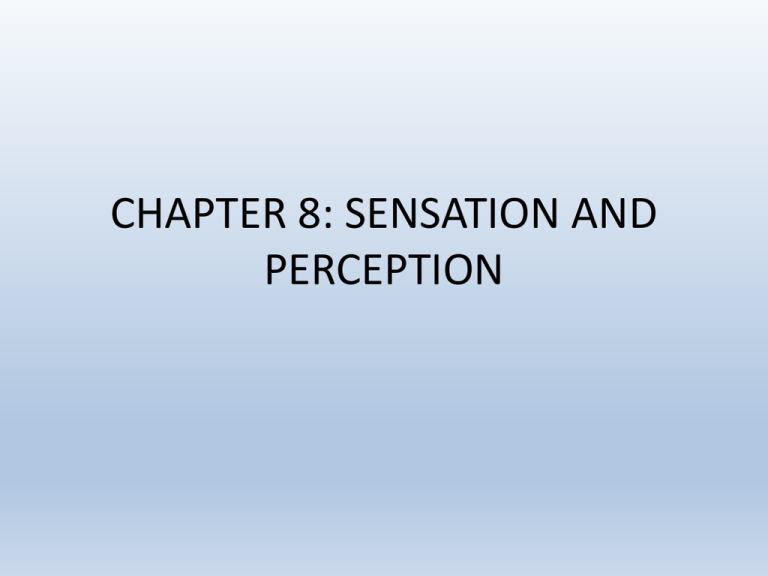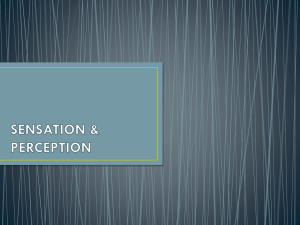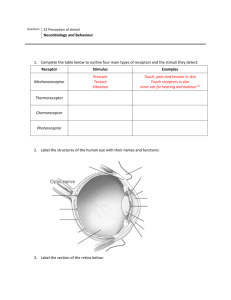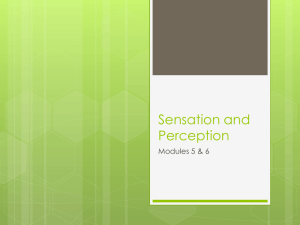CHAPTER 8: SENSATION AND PERCEPTION
advertisement

CHAPTER 8: SENSATION AND PERCEPTION SECTION 1: SENSATION WHAT IS SENSATION? • Def: what occurs when a stimulus activates a receptor • Stimulus: an aspect of or change in the environment to which an organism responds SENSATION CONTINUED • Perception: organization of sensory info into meaningful experiences • Psychophysics: study of the relationships between sensory experiences and the physical stimuli that cause them THRESHOLD • Absolute threshold: the weakest amount of a stimulus that a person can detect half the time • Humans have a very limited range SENSORY DIFFERENCES • Difference threshold: the smallest change in a physical stimulus that can be detected between 2 stimuli • Just Noticeable Difference (JND): the smallest increase or decrease in the intensity of a stimulus that person can detect WEBER’S LAW • For any change in a stimulus to be detected, a constant proportion of that stimulus must be added or subtracted • A.K.A.: Weber-Fechner Law SENSORY ADAPTATION • Senses are tuned to change • Senses adapt to a constant level of stimulation • Necessary to ignore mundane SIGNAL-DETECTION THEORY • Def: the study of people’s tendencies to make correct judgments in detecting the presence of stimuli • Radar operator PROCESSING STIMULI • Preattentive process: extracting information automatically • Attentive process: procedure that considers only one part of the stimuli presented at a time • Stroop Interference Effect SECTION 2: THE SENSES VISION • Most studied sense • Pupil: opening in the iris that regulates the amount of light entering the eye • Lens: flexible structure that focuses light on the… • Retina: innermost coating of the back of the eye, containing light sensitive receptor cells VISION CONTINUED • Cones and Rods: light receptors in the retina; convert light energy into neuronal impulses • Cones: color • Rods: night vision • Optic Nerve: the nerve that carries impulses from the retina to the brain COLOR DEFICIENCY • Affects 8% of American men; <1% women • Dysfunctional cones • Red-green • Yellow-blue • Total deficiency: see in black and white BINOCULAR FUSION • Def: the process of combining the images received from the two eyes into a single, fused image • Retinal Disparity: the differences between the images stimulating each eye • Essential for depth perception NEARSIGHTEDNESS • Eyeball is longer than normal • Objects focused at a point in front of the retina • See objects that are near, but not far FARSIGHTEDNESS • Eyeball is too short • Objects focused slightly behind the retina • Distant objects are clear, near objects are not HEARING • Sound waves: vibrations in the air • Loudness determined by amplitude (height) of waves • Strength determined by decibels • >110 decibels damages hearing HEARING • Pitch depends on sound wave frequency (rate of vibration of medium through which wave travels) PATH OF SOUND • Outer ear (pinna) receives waves • Auditory canal vibrates which vibrates the ear drum • Middle ear: 3 tiny bones--hammer, anvil, and stirrup • Inner ear: cochlea---liquid moves, tiny hairs detect motion, translate into neuronal input and sent to brain by the Auditory nerve DEAFNESS • 2 types: • 1) Conduction deafness: hindered physical motion in the outer or middle ear • Helped with conventional hearing aid • 2) Sensorineural deafness: damage to the cochlea • Helped with cochlear implant BALANCE • Vestibular system: 3 semicircular canals that provide the sense of balance, located in the inner ear and connected to the brain by a nerve • Fluid in canals moves • Hair cells translate motion SMELL • Chemical sense • Gaseous molecules contact smell receptors • Olfactory nerve: carries smell impulses from the nose to the brain TASTE • • • • • • • 5 primary tastes: 1) Sweet 2) Sour 3) Bitter 4) Salty 5) Umami (savory, meaty) Combination of these creates flavor • Taste is more determined by smell SKIN SENSES • Densely bundled nerve endings create sensitivity to pressure • Some are sensitive to hot and cold • Pain results from many different stimuli PERCEPTIONS OF PAIN • Sharp, localized pain immediately after injury • Dull, generalized pain later • Gate control theory of pain: shifting attention away from pain can lessen its effects BODY SENSES • Kinesthesis: the sense of movement and body position • Cooperates with vestibular system and vision • Receptors in and near muscles, tendons, and joints The way we interpret sensations and organize them into meaningful experiences SECTION 3: PERCEPTION GESTALT • Def: the experience that comes from organizing bits and pieces of info into meaningful wholes • Trying to identify principles the brain uses in building perception GESTALT PRINCIPLES • • • • • • 1) Proximity 2) Continuity 3) Similarity 4) Simplicity 5) Closure If elements are close to one another or similar, we perceive them as one set FIGURE-GROUND PERCEPTION • The ability to discriminate btwn a figure and its background • Shows we can perceive in more than one way • Works with sound as well PERCEPTUAL INFERENCE • Filling in the gaps in what our senses tell us • Largely automatic and unconscious • Depends on experience LEARNING TO PERCEIVE • Influenced by needs, beliefs, and expectations • If we want something, we’re more likely to see it • Perceptual set: twisting truth to fit our own belief system SUBLIMINAL PERCEPTION • Subliminal messages: brief auditory or visual messages that presented below the absolute threshold • Not really effective DEPTH PERCEPTION MONOCULAR DEPTH CUES • Can be used with a single eye • Relative height: objects further away are higher on your visual plane • Interposition: overlapping • Light and shadows: brightly lit objects are closer MORE MONOCULAR CUES • Texture-density gradient: close objects have more detail • Motion parallax: the apparent movement of stationary objects relative to one another that occurs when the observer changes position MORE MONOCULAR CUES • Linear perspective: parallel lines converge in the distance • Relative motion: near objects appear to move in the opposite direction that you do; far objects seem to travel with you BINOCULAR DEPTH CUES • Depend on movement of both eyes • Convergence: eyes turn inward when looking at nearby objects • Retinal disparity • Large disparity means close; small means far CONSTANCY • Def: the tendency to perceive certain objects in the same way regardless of changing angle, distance, or lighting ILLUSIONS • Def: perceptions that misrepresent physical stimuli • Happens when perceptual cues are distorted so our brains cannot correctly interpret space, size, and depth cues EXTRASENSORY PERCEPTION • Def: (ESP) an ability to gain info by some means other than the ordinary senses • 4 types: • 1) Clairvoyance: perceiving w/o sensory input • 2) Telepathy: mind reading • 3) Psychokinesis: move things with your mind • 4) Precognition: foretell events I’m a big idiot who likes to rob people of their money by preying on their personal loss





